The Value of Landscape Design
The skill of creating a design is perhaps the most valuable skill in the landscape process because it determines the reward that we receive for the time, money and care we invest. If we value a strong return on a real estate investment, it is design that determines whether the same $25,000.00 and 100 hours spent lowers the value of the property by $10,000.00 or increases it by $75,000.00. If it is personal feelings of joy that we value most, it is design that determines whether we create something for $10,000 and forty hours that leaves us with feelings of ambivalence or spend $7,500.00 and twenty hours creating something else that brings us a deep sense of joy and satisfaction.
The art of design, is ultimately the art of aligning each of our decisions consciously in accordance with our values. Design is a decision-making process that can be applied to any area of our lives, providing we know enough technical information to understand which choices are most congruent with our values.
There are many values that different people hold as the guiding lights of a landscape design process. These range from desires to assuage guilt and please the neighbors to providing serenity with a minimum of effort. Here are some of the values I often reference in design:
- “Minimum effort for maximum result” results in a natural respect for what is and a desire to take the path of least resistance, while still achieving the goals of the client. This value suggests that if one type of stone looks only 20% better to a specific client than another type of stone but costs 300% more than the cheaper stone be used. The savings can be spent in some other area that delivers a stronger yield on the personal values of the client.
- “Easy to Use and Maintain” begins with understanding the functional needs of the home-owner, as well as the maintenance budget, and/or
hours a week they wish to care for their garden. It suggests understanding how many cars may need to be parked, locating a compost or vegetable garden near the kitchen, and installing things with long-term maintenance in mind.
- “Emotional Rapport with People” Respects the fact that two similarly priced plants are not necessarily equal in the eyes of the individual home-owner. One plant may have sentimental value that is ten times higher than an equally attractive plant that has no positive memory associations. A large function of gardens is to bring pleasure and well-being and to do so it is important to understand the mental and emotional associations of the individuals affected and work with them.
- “Balance between Chaos and Boredom.” Every design finds its unique balance between these two continuums. And often the most satisfying designs have an equal mix, perhaps combining a strong and symmetrical hardscape with a flowing and informal planting pattern. It is a balance that again begins with the individual, and it includes the house as well. A very formal house can sometimes benefit by an equally informal landscape, each balancing the other.
There are other values that can serve as guides for the literally millions of choices in plants, materials, shapes and scales we must wade through as we decide on our own unique design. What is important is to know what our values are, and then to educate ourselves on which of the choices available best serve not one, but all of our values simultaneously. In this way our values are our friend – helping us to narrow the vast array of choices down to a manageable level. There may be hundreds of plants that we “like,” but only a handful that meet one persons value of “evergreen, low maintenance, drought tolerant, 2-3’ high
and deer resistant.” Defining what is important to us helps focus us enough to see which of the plants we not only like visually, but relative to our design values.
This plant example also demonstrate the value of starting with abstract concepts and making them more literal. In the example above, evergreen might either tie into the value of low maintenance (evergreen plants usually are) or to the value of having year-round interest, which may be particularly important for a front entrance. By starting with an intimate understanding of what is important to us, these values guide us when we are faced with a specific decision. Drought tolerant and low maintenance may be a function of wanting to enjoy the garden without feeling pressured to constantly tend it, or may stem from a respect for environmental resources and an intention to save water. In each case, as we are clear about our values, they can guide us in the small decisions that can otherwise become overwhelming.
One of the most valuable design principles I have learned came from another arena entirely. In “Seven Habits of Highly Effective People” Stephen Covey talks about the need to focus on the most important things and let the details work their way into the cracks at the end. In a landscape it is the functional layout of paths, steps, parking and activity areas that create flow and easy use. Next come the trees, the main plant themes and shrubs. And finally the ornamentation. For this reason I draw out all the main bed-shapes, elevations, driveways, pathways and activity areas before I do anything else. Next I design the biggest plant themes in abstract form. And only then do I look at the specific materials to use for walls, rock placement and planting.
"Dane visualized and installed a back yard where we had nothing but a slope before."
Jan and Dick Beal
(415) 455-9161





